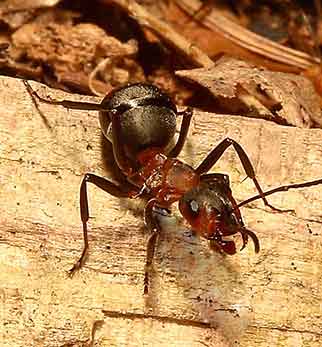New Forest insects - an introduction to some notable species

How many people take an interest in insects? Of course, brightly coloured butterflies and dragonflies attract attention, but otherwise ‘not many’ is the likely answer. Yet the New Forest is home to a wide variety of insects, many of which are large and prominent, easy to see and have fascinating lifestyles.
Hornets, for example, enormous, cavity-nesting social wasps, are widespread in the New Forest where decaying trunks and boughs in the ancient, unenclosed woodlands provide ideal sites for them to build their intricately constructed nests.
Boldly impressive stag beetles are also quite common. In fact, the New Forest is something of a British stronghold for these increasingly scarce creatures, offering a relatively mild climate and abundant dead and decaying timber on which the larvae feed before, after 3-5 years, emerging as the familiar, sometimes fiercely combative, winged adults.
Then there are a number of species of dung beetles. These incredible creatures lay their eggs in specially dug underground chambers provisioned with neatly rolled balls of animal dung that will sustain newly hatched youngsters until the time when they can collect their own supplies of the same nourishing materials.
Southern wood ant nests are common, too, particularly in the coniferous inclosures. Impressive citadels up to 90 centimeters (36 inches) high and 180 centimeters (72 inches) in diameter, they are constructed primarily of pine needles and other woodland debris, and are often home to tens of thousand of ants living highly structured lives in well-organised colonies.
Common Cockchafers - often known as May Bugs - are also quite common and widespread around the New Forest's towns and villages, and despite these insects' nocturnal habits, many people are, at the very least, generally familiar with these strange looking, robust creatures.
And of course, there’s many more, but this small selection might be sufficient to encourage interest in what is a largely unknown world, a world that it's a privilege to observe and try to understand.
Find out more about other notable insects
New Forest Insects - a photographic guide
If you have an interest in New Forest insects - butterflies, dragonflies and damselflies, beetles, bugs or just about anything else - look out for the photographic guide (published in May 2011) produced by local expert Paul Brock.
Look out, also, for Paul's new book, A Comprehensive Guide to the Insects of Britain and Ireland, which was published in spring 2014.
Quick linksMore links
Search this site

Sadly, 58 animals were killed - 35 ponies, 13 cows, 8 donkeys and 2 sheep, whilst a further 32 were injured - 3 pigs, 9 donkeys, 11 cows and 9 ponies.
(Forty-three accidents occurred in daylight, 15 at twilight and 101 in the dark. Twenty-seven accidents were not reported by the driver involved).
Here's just one horrific example - Three donkeys killed in collision with van at notorious New Forest blackspot (Advertiser and Times)

